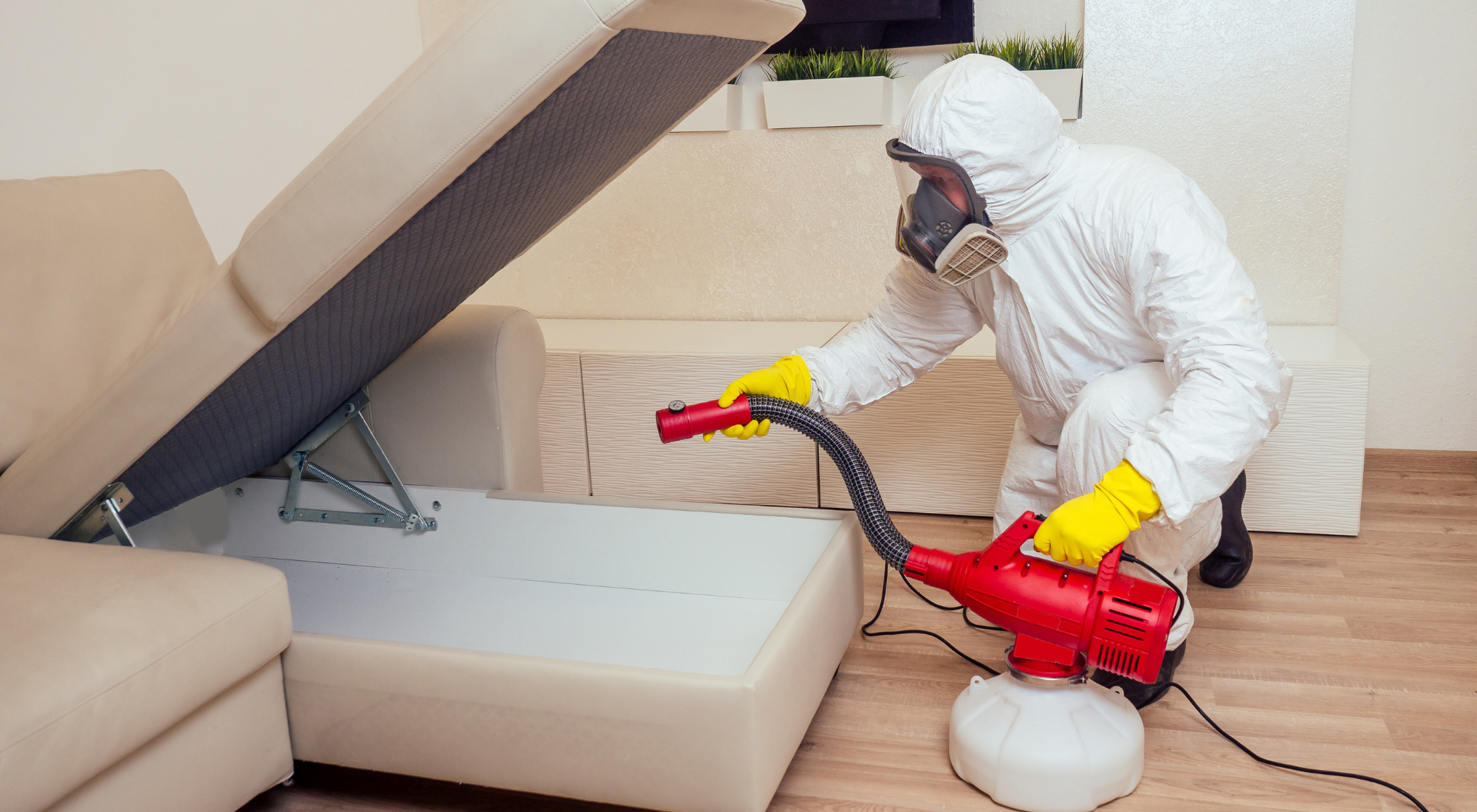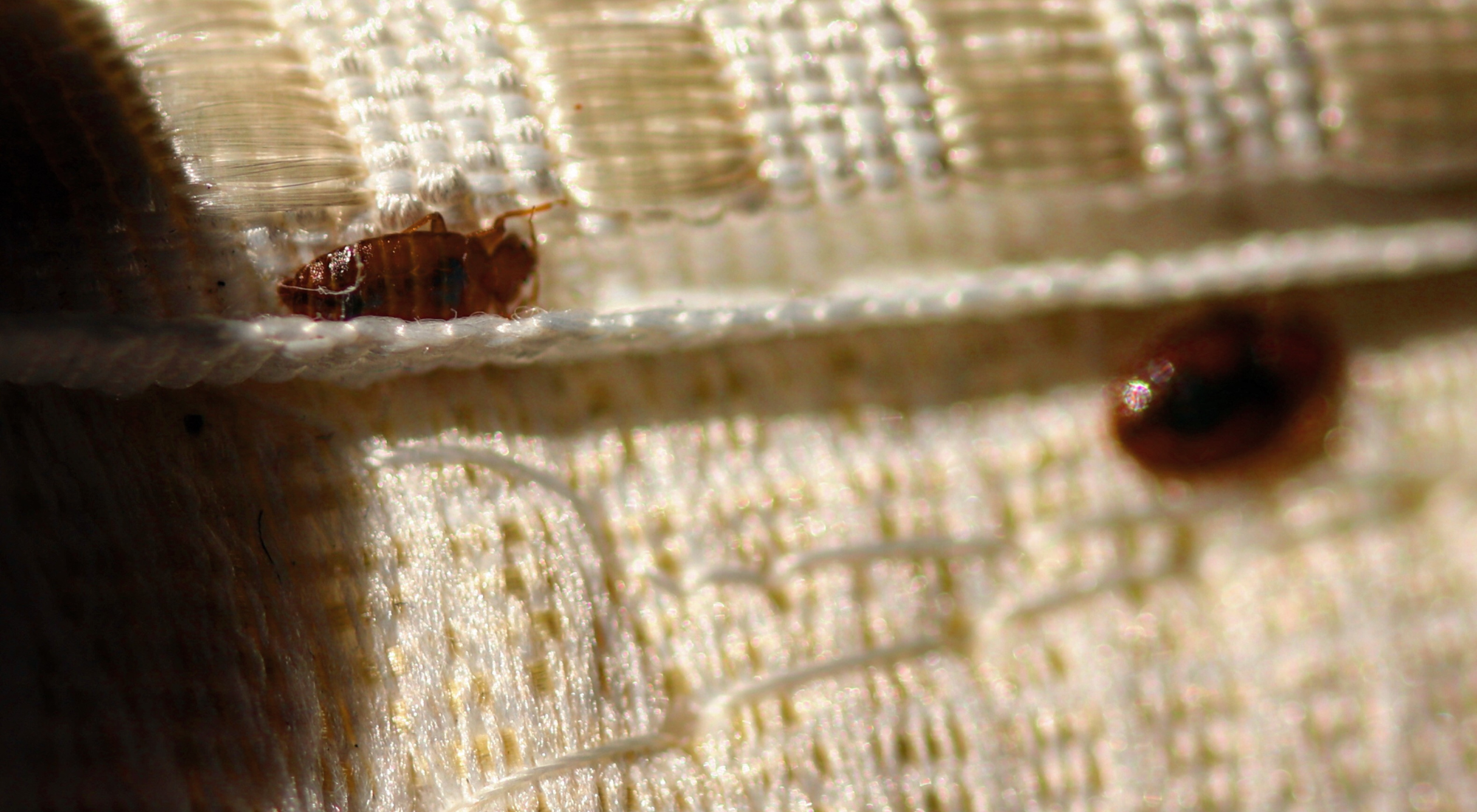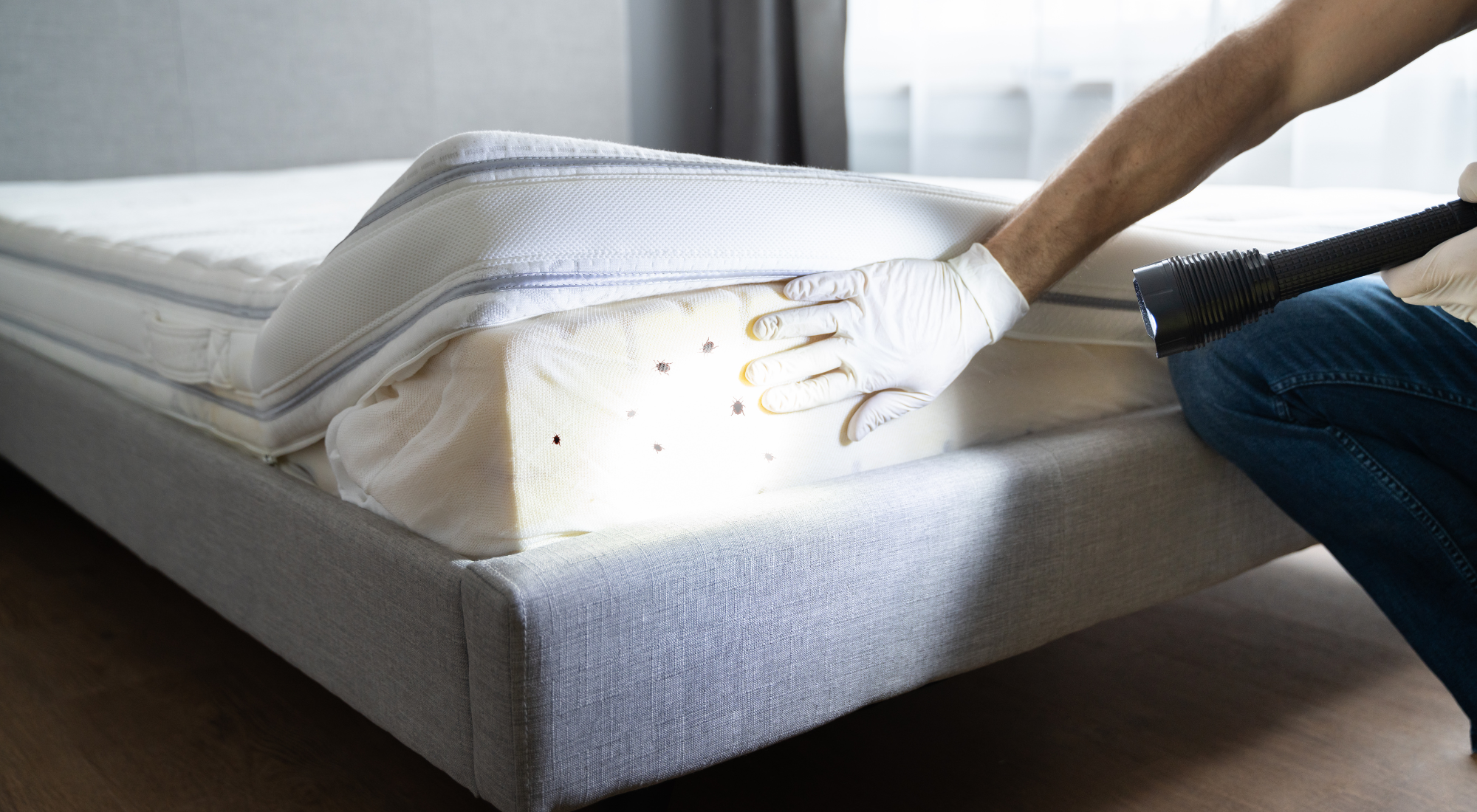If you’ve dealt with bed bugs, you know they’re an absolute nightmare. Bed bugs are an increasingly common problem that can cause considerable distress and disturbance in your everyday life.
Fortunately, there are two reliable methods of treating bed bugs — heat treatment and chemical treatment. In this article, we compare heat treatment and chemical treatment for bed bugs to help you decide which method is best for you.
Keep reading to understand the effectiveness, advantages, and drawbacks of each heat vs. chemical bed bug treatment so you can make an informed choice when it comes to bed bug treatment.

Table of Contents
- Understanding Your Options for Bed Bug Treatment: Heat vs. Chemical
- The History of Chemical Bed Bug Extermination
- What Does Chemical Treatment for Bed Bugs Look Like?
- What Does Heat Treatment for Bed Bugs Look Like?
- Effects of Heat Treatment vs. Chemical for Bed Bugs
- How To Decide Between a Chemical vs. Heat Treatment for Bed Bugs
- Rid Your Home of Bed Bugs With Heat Treatment From Pure Environmental
Understanding Your Options for Bed Bug Treatment: Heat vs. Chemical
Bed bug infestations can be an incredibly frustrating problem for homeowners and businesses alike. That’s why it’s important to understand your options when it comes to treating bed bugs.
Heat treatments involve raising the temperature in affected rooms to levels that are lethal to bed bugs. This is done by using specialized heating equipment to create a bed bug environment lethal to bed bugs. Heat treatments are highly effective, but they may not reach all the areas where bed bugs are hiding if the treatment’s duration/temperature isn’t monitored and managed well.
Chemical treatments involve the use of insecticides to kill bed bugs. Chemical treatments can be effective, although they often take more than one application and there can be some health risks associated with using pesticides in the home.
If you’re looking for the most effective way to quickly get rid of bed bugs in the Pacific Northwest, Pure Environmental can help. We’re experts in the use of heat treatments to exterminate bed bugs, and we can provide you with the best solution to get rid of your bed bug problem.
The History of Chemical Bed Bug Extermination
The history of chemical bed bug extermination is a long and checkered one. Back in the 1940s, DDT was the chemical of choice, and humans eliminated an estimated 95% of bed bugs in existence using DDT. However, the 5% that remained were resistant to DDT, and they started to multiply again.
How is that possible? There are several ways bed bugs began to resist even the most toxic chemicals:
- Natural selection — Bed bugs were able to develop a resistance to certain chemicals through natural selection, whereby resistant bugs were able to survive and reproduce.
- Genetic mutations — Certain genetic mutations allowed bed bugs to develop a resistance to DDT.
- Chemical evolution — Bed bugs were able to evolve over time to become resistant to certain chemicals due to selective pressure from the environment.
- Behavioral changes — Bed bugs have been known to develop avoidance behaviors or other strategies to help them survive in a chemically infested environment.
This resistance has forced the pest control industry to find alternate solutions, as these chemicals no longer offer the same effectiveness they once did.

What Does Chemical Treatment for Bed Bugs Look Like?
Each treatment will typically include multiple products designed to kill adult bed bugs. The treatment will involve applying different products to areas where bed bugs may be hiding. This application will typically involve multiple products including sprays, foams, and dust products.
In addition, any items that cannot be treated with chemicals may be heated, or placed into plastic bags or containers along with off-gassing products.
Pros of Chemical Treatment for Bed Bugs
Chemical treatment for bed bugs can be an effective solution for eradicating an infestation quickly and reliably, especially if you catch it early. Here are some of the pros of chemical treatment:
- Quick-acting pesticides mean that you can target bed bugs throughout their entire life cycle, often eliminating them in the early stages of infestation.
- Residual chemicals can act as a barrier against future infestations, providing long-term protection.
- Generally, chemical treatments are more cost-effective than heat treatments, so you can save a bit of money.
Chemical treatments are most likely to be effective if applied as a resdiual after a heat treatment. If you’re unsure the best course of action for your bed bug problem, you should always consult a professional exterminator. If you’re in Portland or Tacoma, Pure Environmental can help you find the right solution to your bed bug problem.
Cons of Chemical Treatment for Bed Bugs
When it comes to treating bed bug infestations, chemical treatment has some drawbacks that should be considered. These include:
- Lots of prep work — The chemicals must reach the bed bugs, so infested areas have to be thoroughly prepared with as few barriers as possible.
- Leaving chemicals in your home — Although the chemicals are generally considered safe, people with chemical sensitivities or pets in your home may not be comfortable with this option.
- Ineffectiveness on bed bug eggs — Chemical treatments do not usually kill bed bug eggs, making multiple treatments necessary.
- Not guaranteed to get you bed bug free — Pest exterminators must carefully target the areas where the bed bugs are concentrated, making the treatment less convenient and discreet.
Even though chemical treatments can provide long-lasting protection from bed bug infestations, it’s important to weigh the pros and cons before deciding which is best for you.
How Long Does Chemical Treatment for Bed Bugs Take?
Chemical treatments for bed bugs typically involve performing three individual treatments two weeks apart. So, about six weeks total.
As bed bugs have become increasingly chemical resistant, modern chemical treatments involve rotating different products to ensure some of the chemicals being used will kill bed bugs.
What Does Heat Treatment for Bed Bugs Look Like?
Heat treatment for bed bugs is a safe, non-chemical approach to exterminating them in all life stages. By using powerful heaters and fans, professionals can heat a home evenly to temperatures above 140°F, killing any bed bugs present.
This process may require some preparation, like gathering up all items the heat may damage such as wax-based products, aerosol cans, medications, house plants, vinyl records, and more.
Pros of Heat Treatment for Bed Bugs
Heat treatment is recognized as an extremely effective solution to bed bug eradication. It offers a range of benefits over chemical treatments, such as:
- Proving most effective — Heat is the most effective tool available to exterminate bed bugs as recommended by the CDC.
- Being a comprehensive treatment — Heat penetrates beds, furniture, electronics, wall voids, and clothing, ensuring complete pest treatment.
- Being quick — The entire process takes 6-10 hours and requires minimal disruption.
- Killing other bad things, too — Heat treatment kills bacteria, viruses, allergens, and spores in addition to killing bed bugs.
- Lack of chemicals — Heat treatment is a more natural, chemical-free solution for bed bug eradication.
Cons of Heat Treatment for Bed Bugs
When considering heat treatment for bed bugs, it is important to understand the potential drawbacks that come with this method. Here are some of the things to look out for before you commit:
Bed bugs may reinfest — Heat treatment does not offer any residual effect, as bedbugs located offsite may hitch a ride back into a treated home.
Some things could be damaged — Heat-sensitive items, like candles or vinyl records, may have to be removed to ensure they are not harmed by the heat. A knowledgeable pest control expert can provide guidance on what can remain in your home and what needs to be taken out.
How Long Does Heat Treatment for Bed Bugs Take?
Heat treatment is the fastest and safest way to get rid of bed bugs. At Pure Environmental, our heat treatment method eliminates bed bugs in just one day!
We recommend heat treatment because it eliminates all bed bug stages — eggs, nymphs, and adults — without the need for chemicals. Plus, there’s no need to pack up your belongings or deal with the hassle of chemical treatment clean up.
Get your bed bug problem solved quickly and safely with Pure Environmental’s heat treatment.
Effects of Heat Treatment vs. Chemical for Bed Bugs
Both heat treatment and chemical treatment have their pros and cons. It’s important to weigh the effects and potential issues with each method before committing.
Heat treatment is beneficial in that it can effectively kill pests during a single session, especially for severe infestations. However, this method of treatment relies heavily on customers’ compliance with preparation instructions to ensure no damage to personal items. The heat treatment technician also must understand the heating process and the potential for cold spots.
If any infested areas are missed, the problem will continue to worsen as bed bugs continue to reproduce. Additionally, bed bugs can sometimes escape from the heat, making the heat treatment less effective than a blanket chemical treatment in some cases unless the entire structure or unit is treated.
On the other hand, chemical treatments are often associated with health risks and can be less effective for severe infestations. This method requires multiple treatments, and the chemicals used can cause health issues if not applied correctly. The chemicals can also be dangerous to high-risk individuals, pets, and other animals that may come into contact with them.
Ultimately, it comes down to what you are most comfortable with and professional recommendations from pest control experts. Every infestation is different.

How To Decide Between Chemical vs. Heat Treatment for Bed Bugs
Ultimately, the decision between heat treatment and chemical treatment depends on a variety of factors, including safety, cost, timeline, and effectiveness.
- Heat treatment is generally considered to be safer than chemical treatment, as it does not involve the use of harsh chemicals.
- Chemical treatment is typically more affordable than heat treatment.
- Heat treatment can typically be completed in one day and does not require the evacuation of the area, making it more efficient than chemical treatment.
- Heat treatment is generally more effective at reaching into cracks and crevices, while chemical treatment may require multiple treatments and post-treatment inspection to ensure all bed bugs are eliminated.
Consulting with a pest control professional can help determine which method would be most effective for a particular situation.
At Pure Environmental, our team of experts can help assess the situation and advise on the best course of action for eliminating bed bugs.
Factors To Consider When Deciding Between Heat vs. Chemical Bed Bug Treatment
When deciding between heat treatment and chemical treatment for bed bug infestations, it is important to consider the specifics of your space and infestation before taking action. For example:
- Type of space — Some spaces are hard to heat or have sensitive items that would be impossible to remove, so chemical treatments may be the only option.
- Severity of infestation — Severe infestations may require intensive and large-scale treatments, which may make heat treatments more practical, as chemical treatments can be more targeted and less invasive.
- Kids and pets — Heat treatments are the safest option for households with children and pets, as chemical treatments can be toxic to those groups.
- Budget — If you’re on a budget, chemical treatments might be the cheapest option.
- Timeline — If you must get rid of bed bugs in a hurry and can’t wait six weeks for a full chemical treatment, a one-day heat treatment may be your best bet.
Rid Your Home of Bed Bugs With Heat Treatment From Pure Environmental
With their specialized equipment, highly-trained staff, and locations in Portland, OR, and Tacoma, WA, Pure Environmental is the perfect choice for eliminating bedbugs and restoring your home.
Their services are highly competitive and their customer service is top-notch. Don’t wait — contact Pure Environmental today!
Recent posts
- Advice From the Pros: How To Hire a Contractor for Home Renovations
- After the Fire: What To Expect From Smoke Damage Restoration Services
- Home Insurance During Renovations: What Is Covered and What To Know Before Getting Started
- Mitigation and Restoration: Understanding the Difference Between the Two and Why They’re Both Necessary
- Should You Stay or Should You Go? Know When To Walk Away From a House With Mold
